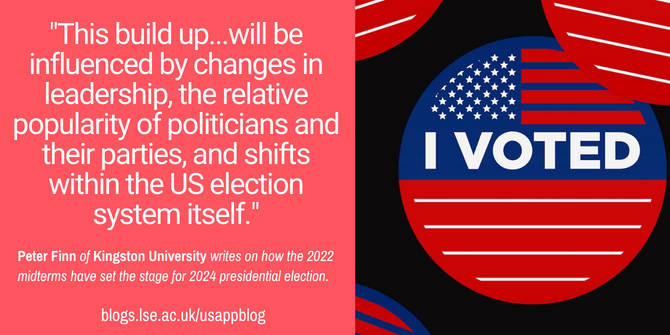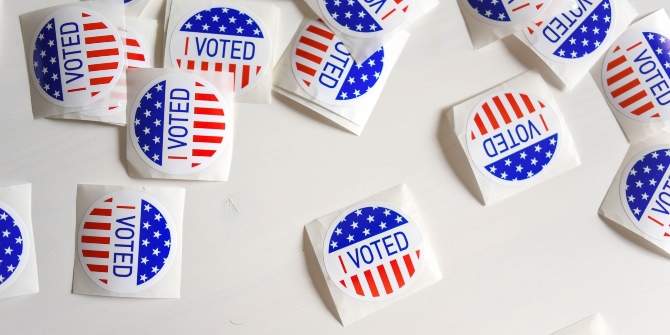 The 2022 midterm elections meant a return to Republican control of the US House of Representatives and have marked the beginning of the run up to the 2024 presidential election. Peter Finn gives an overview of a new a PSA American Politics Group briefing paper which analyses the results and developing trends from the 2022 Midterm elections including federal and state-level results, and what the elections mean for the Democratic and Republican parties.
The 2022 midterm elections meant a return to Republican control of the US House of Representatives and have marked the beginning of the run up to the 2024 presidential election. Peter Finn gives an overview of a new a PSA American Politics Group briefing paper which analyses the results and developing trends from the 2022 Midterm elections including federal and state-level results, and what the elections mean for the Democratic and Republican parties.
As the 118th Congress beds in, what can we learn from initial analyses of the 2022 midterms that may feed into longer term understandings of the elections? For a recent briefing paper published by the American Politics Group of the Political Studies Association, I led a group of scholars asking just that question. Across eight chapters of this briefing, titled Exploring the 2022 Midterms, we examined different aspects of the midterms at state, regional, and federal levels. Given the short timeframe, the results were (we hope), surprisingly nuanced. Below, drawing directly from brief chapters, I map some key takeaways.
Pre-Election Narratives
As elsewhere, in US elections the narratives which develop, media coverage, and broader discussions are all closely linked and feed off one another and are all key to how elections are framed and understood. Something as true during the lead up to the 2022 midterms as it has been in previous elections. Yet, given the complexity of the US electoral system, there are multiple ways to explore such narratives at federal and state levels.
Federal: At a national level, Clodagh Harrington of University College Cork & Alex Waddan of the University of Leicester explored inflation and reproductive rights, framed respectively as material and post-material issues, as voter priorities in the lead up to the midterms. Ultimately, the results suggested a more nuanced issue environment than captured by a simple inflation or abortion rights dichotomy. Overall exit polls, for instance, reported that only 31 percent of respondents said inflation was the most important issue, with 27 percent saying abortion. Yet, 71 percent of the former voted Republican, and 76 percent of the latter voted Democrat.
State: Discussing events in Florida, Felicia Ronnholm of Kingston University explored contrasting narratives about climate change. On the one side, Democratic gubernatorial and senatorial candidates, Charlie Crist and Val Demings, framed Hurricane Ian, which hit Florida in the lead up to the Midterms, as proof that climate change is real and requires urgent action. Contrarily, Ron DeSantis, the incumbent Republican governor, abstained from mentioning climate change when speaking of Ian, and Marco Rubio, the Republican senatorial incumbent, avoided making references to the climate crisis.
The results
The headline takeaways federally were that the Democratic Party held onto a Senate majority; increasing it by one initially though Arizona Senator Kyrsten Sinema has since become an independent who caucuses with the Democrats rather than a formal party member. In the House of Representatives, Republicans eked out a small majority despite a divided and restive causes.
State level elections: Exploring the elections at a state level LSE USAPP Blog Editor Chris Gilson documented Democratic success, noting the party gained four legislative chambers, and the number of Democratic trifectas increased to 14. The party also added three governorships, though results in New York and New Mexico point to Democratic vulnerability to Republican attacks on crime. Noting the place of money within state level politics, Gilson highlights that over £1 billion was spent on the 140 ballot measures campaigns voted on by Americans in 2022. In California, in an unsuccessful ballot measure pertaining to gambling, an eye watering $300 million was spent by those campaigning for and against the measure. As such, over half a billion dollars was spent to preserve the status quo.
Intersectional representation: Exploring diversity in the midterm results, Amy Tatum of Bournemouth University noted that there was no significant change for numbers of women in the United States Congress. At a state level, record numbers of women were elected in gubernatorial races, though there was a lack of intersectional leadership within this cohort. There were, meanwhile, significant victories for trans and non-binary people at state level races that showed promise for substantive representation moving forward.

Photo by visuals on Unsplash
Republican Party: In a chapter focused on New England and the Mid-Atlantic states of New Jersey, New York, and Pennsylvania, meanwhile, Matthew Schlachter explored the fate of Moderate Republicans. Pushing back against popular perception that Moderate Republicans no longer exist, Schlachter documents that Moderate Republican candidates continue to run in elections for federal and state offices, though their chances of success in contested primaries is increasingly precarious. That said, in New England and the Mid-Atlantic, and despite limited victories, moderate Republican candidates were more competitive than their more conservative counterparts – tending to overperform the partisan lean of their congressional districts in US House of Representatives elections and coming closer to defeating their Democratic opponents.
Turning to the Republican Party more generally Michael Espinoza argues the elections were a missed opportunity but not a complete failure for the party. Reflecting this, while a red wave did not materialise, the Republican Party did win a narrow US House majority. Looking both forward and backwards, Espinoza notes that though the Republican Party still grapples with the Trump dilemma, moving on from Trump will not be easy, nor would it signal change within the Republican Party. Arguing that ‘Make America Great Again’ cultural conservatism took hold of the party before Trump – it merely went by another name.
Towards 2024
Looking forward, attention in US politics will increasingly be dominated by the build up to the 2024 Presidential Election. This build up, and the election itself, will be influenced by changes in leadership, the relative popularity of politicians and their parties, and shifts within the US election system itself.
House Leadership Changes: The 2022 midterms results meant a Republican Party takeover of the House of Representatives, albeit with a slim and restive majority, with Kevin McCarthy finally elected as speaker on January 6, 2023, following 15 rounds of voting split across four days. One imagines that the drawn-out election for the speakership will be a harbinger of the future problems McCarthy will face as he seeks to manage the dual pressures of a fractious body of Republican lawmakers and a wafer-thin majority. Indeed, he is likely to face significant difficulties keeping together a congressional caucus. Meanwhile, the Democrats achieved an orderly succession of power from the old guard, personified by former speaker Nancy Pelosi, to new House minority leader Hakeem Jeffries, a 52-year-old, four-term New York congressman. The party also replaced the two other top ranking House leaders, Steny Hoyer and Jim Clyburn, both in their 80s, with 59-year-old Katherine Clark and Pete Aguilar, 43. An obvious point perhaps, but one imagines that if either party can maintain discipline, it will bring benefits in a finely divided chamber.
Democratic Party: Exploring the prospects for the Democratic Party, Caroline Leicht of Southampton University posits that while the midterms turned out better for Democrats than expected, a split Congress poses significant challenges to President Biden. Discussing the possibilities for those who may run for president in 2024 if Biden does not, Leicht highlights that approval ratings for Vice President Kamala Harris have started to improve after the midterms. Meanwhile, both Secretary of Transport Pete Buttigieg and Michigan Governor Gretchen Whitmer have emerged from the midterms as rising stars.
More procedurally, as I document with Robert Ledger the Democrats, in an initiative led by Biden, are aiming to recalibrate the primary timetable in 2024 to dilute the role of Iowa and New Hampshire, with South Carolina proposed as the first primary. As Caitlin Jewitt and Gregory Shufeldt highlight in a previous post on this site, however, the proposals face multiple hurdles including the fact that ‘the presidential primary is a series of sequential elections conducted and administered by the states’, meaning even if a national party proposes something this ‘does not guarantee that state governments will follow or acquiesce’.
- This article is based on “Exploring the 2022 US Midterms,” a PSA American Politics Group (APG) briefing paper consisting of eight chapters analyzing aspects of American politics in relation to the 2022 Midterms and available on the PSA APG website.
- Please read our comments policy before commenting.
- Note: This article gives the views of the author, and not the position of USAPP – American Politics and Policy, nor the London School of Economics.
- Shortened URL for this post: https://bit.ly/3EmGIyL





